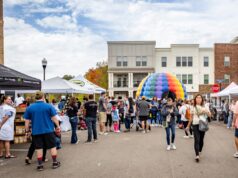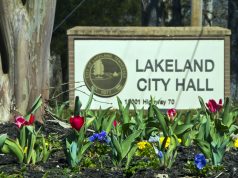By Jim Willis, MPDRC member
The Municipal Planning and Design Review Commission (MPDRC) focused tonight (6.15.17) on the importance of establishing a vision for what could become the town center for Lakeland through development of the three quadrants not covered by The Lake District at the I-40 junction with Canada Road.
Looney, Ricks, Kiss (LRK) was commissioned last year to meet with stakeholders in Lakeland through a series of public meetings to develop a Small Area Plan to address the potential of the southwest, northwest and northeast quadrants of the interchange. The southeast quadrant will be the site for The Lake District project.
Jonathan Flynt with LRK told MPDRC members the goal was to provide Lakeland with a tool to take ownership of the area by establishing a vision, including specific design guidelines, for cohesive development of what could become the town center or focal point for Lakeland.
“This can become a template for all Type V zones,” said Don Barber, MPDRC chairman. “We also need to stake out what we want US-70 to be.”
Mr. Flynt said the Small Area Plan for the area around the interchange gives Lakeland the form and the look wanted, but the flexibility to work with existing land owners or to assemble large tracts to promote cohesive development by working with private developers.
MPDRC Commissioner Kevin Hammeran said establishing a template for not only the interchange, but also for US-70 is important as “US-70 could someday look just like US-64 if we don’t do something.”
Tom Skehan, Lakeland planning director, said the staff will prepare an “Interchange Overlay District” that will go beyond the Neighborhood Type V districts and “provide for public open space like a town square” for one of the three quadrants. He said the vision is that the town square open space will provide for the “community to gather for festivals or special occasions.”
The higher density development nearest the interchange would transition to lower intensity retail, commercial and residential uses as a buffer to existing residential areas.
The three quadrants together could total 325,000 square feet of commercial space, 291 townhomes and 73 single-family detached houses. “Assuming conservative benchmarks” of $130 per square foot for commercial value, $200,000 per townhouse and $263,800 per single-family house, Mr. Skehan said, the three quadrants could generate annual property taxes of more than $45 million.
He estimates sales taxes generated through retail development in the Small Area Plan would be more than $7.6 million annually, less any Tax Incentive Financing (TIF) needed to stimulate projects.
The MPDRC also discussed measures under consideration to protect property values by using Land Development Regulations to control proliferation of “Alternative Financial Services” (AFS) businesses such as cash advance, check cashing, pawnshops and title loan establishments.
Chairman Barber said it’s important to note that such businesses produce no significant tax revenue for the community and that high-traffic locations such as US-64 are better utilized by retail businesses that do provide tax benefit to Lakeland.
Mr. Skehan said he would bring a proposed ordinance governing AFS businesses to the MPDRC for consideration at a future meeting.
In the one item voted on by the MPDRC, commissioners unanimously approved the rezoning of a tract of land north of Lou Jan Causeway, most of which is zoned agricultural, to R1 residential to allow Jared and Mary Welch to build a house on a portion of the property for themselves and subdivide the remainder of the property.
The property is bordered by land to the north that is owned by the City of Lakeland, which plans to use it for an athletic complex.










